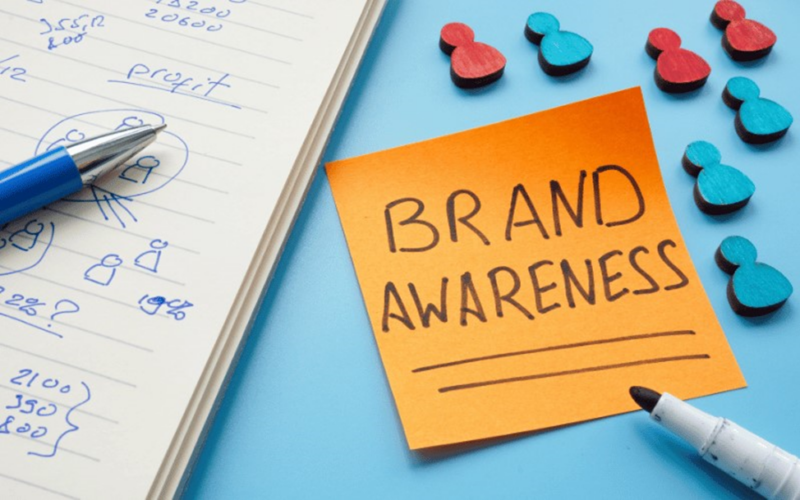Are you facing challenges in establishing a unique brand identity in a highly competitive market? Is your innovative product or service struggling to stand out among competitors?
Your ‘Brand’ is more than just a name. It’s your Story, and a ‘Brand Awareness Campaign’ is the tool that brings your brand’s story to life. Grasping the significance of this campaign is not just a theoretical exercise but a practical necessity in today’s market. Creating a successful brand awareness campaign is essential for any SME looking to thrive in today’s competitive landscape.
“A brand is the set of expectations, memories, stories and relationships that, taken together, account for a consumer’s decision to choose one product or service over another.” – Seth Godin.

In the forthcoming blog post, we will explore brand awareness in depth, delving into its indispensability, significance, and substantial influence on customer allegiance and market share. We will also elucidate how brand awareness can be harnessed to develop user-centric products that foster enduring business expansion for small and medium enterprises (SMEs).
What is Brand Awareness?
Brand awareness is how well consumers recognize and remember your brand name, logo, or imagery. It measures how familiar people are with your brand and how easily they can recall it when prompted. It is crucial to ensure consumers can recall and remember your brand.
People encounter numerous stimuli throughout the day, and those little moments can spark thoughts. You want your brand to be associated with those thoughts.
As SMEs or start-up founders, you have the power to create more than just a brand. You can create an experience that stands out and becomes a part of your consumers’ daily lives. Building strong brand awareness is not just about making your brand known; it’s about making it unforgettable.
Let’s delve into the profound impact of Nike’s ‘Do It ‘campaign. It’s not just a slogan; it’s a testament to the transformative power of brand awareness. When you see the iconic Swoosh, it’s not just a logo; it’s a surge of energy, a connection to motion, speed, and success. This emotional bond, the heart of brand awareness, sets Nike apart. Their campaign effectively communicated their values, forging a lasting emotional bond with consumers and inspiring them to ‘Just Do It’ with Nike.
Did you know? It takes about 5 to 7 impressions for people to remember a Brand.
To enhance your business’s brand awareness, ensure that your messaging is contextually relevant and communicates the value of your brand, making it easy for people to find you when they need your products or services.
Why is Brand Awareness Important?
Brand awareness is not just a necessity but essential for your business’s overall success and growth. Let’s delve into the myriad benefits of brand awareness that can transform your business:
Consumer Trust and Loyalty: It builds trust when consumers are familiar with your brand. This trust, in turn, fosters customer loyalty, as people are more inclined to purchase from brands they know and believe in. Brand awareness’s familiarity often translates into reliability, making customers feel more at ease in selecting your products or services over those of competitors.
Competitive Advantage: In a crowded marketplace, standing out is essential. However, building high brand awareness can be challenging, especially if competing with well-established brands.
A strategic and consistent approach to ensure your brand is recognized and recalled by consumers. When consumers recognize and recall your brand, they are more likely to choose it over others, giving you a significant edge in the market.
Increased Sales and Market Share: Building strong brand awareness can drive higher sales volumes and increase your market share. A trusted brand is often the first choice for consumers, leading to more frequent and larger purchases.
Influence on Consumer Behavior: Brand awareness significantly influences consumer choices. There are multiple options, and consumers are more likely to select a brand they recognize and associate with positive experiences.
This influence can tilt purchasing decisions in your favor, even in highly competitive categories, giving you the power to shape consumer behavior.
Foundation for Brand Equity: High brand equity leads to numerous benefits, including charging premium prices, attracting better talent, and negotiating favorable deals with suppliers and partners. Brand equity grows due to heightened brand awareness and the delivery of favorable customer experiences.
Supports Marketing Efforts: Strong brand awareness amplifies the effectiveness of your marketing efforts. Campaigns for well-known brands tend to perform better because consumers are already familiar with the brand. This step enhances the impact of your advertising, promotions, and other marketing activities.
Enhanced Customer Perception: Consistent visibility and positive associations can lead to a strong brand image, influencing how customers view your products or services. A positive brand image can lead to higher perceived value and preference among consumers.
Brand awareness is a foundational aspect of any successful marketing strategy. It helps build trust, gives you a competitive edge, drives sales, influences consumer behavior, and lays the foundation for substantial brand equity. Prioritizing brand awareness ensures that your brand remains top-of-mind for consumers, fostering long-term growth and success.
If you want your brand to thrive, you need a solid plan to establish its reputation and generate hype. However, where do you begin? Let’s deep dive and understand the following methods as they are the foundation of your strategy to grow your brand awareness:
Brand Positioning: How people perceive a product, service, or company is its brand. Brand positioning helps consumers understand why your product is a better choice. Electric car maker Tesla is a leader in brand positioning.
Although its products are more expensive than those of its competitors, the company doesn’t include the price in its branding. Instead, it focuses on its vehicles’ long-range, eco-friendliness, and luxury features.
Clear Messaging: Before you communicate your brand positioning, ensure that your message is crystal clear, relevant, and concise. Long and convoluted messages can leave your audience feeling confused and uncertain. However, a clear message empowers them with the information they need to make informed decisions.
Consistent Visual Identity: Visual identity is part of the brand identity. It comprises your logo, colors, typography, iconography, photography, and patterns. It helps your consumers remember your brand.
Multi-channel Presence: The elephant in the room is multi-channel presence. It combines direct and indirect communication channels: direct mail, Digital ads, and social websites where consumers can choose their voice. It’s about reaching people. How, When, and where are they?
Community Connection: It’s not just a business strategy; it’s about creating a space where people can come together to support and learn from one another. By fostering healthy connections, we can help each other grow and make meaningful progress in our journey together.
There are many ways to build that connection and create a psychological space for your consumers, and it all starts with being there for your community. This sense of community makes your audience feel valued and part of something bigger than a brand.
How to Build Brand Awareness and Increase It
As a founder or part of a startup or SME, building and increasing brand awareness is crucial for establishing your business as a trusted service provider in the market. Here’s how you can do it,
Understand Your Audience
Research and Segment: To authentically connect with your audience, it’s essential first to understand who they are. Market research provides invaluable insights into their preferences, needs, and behaviors.
Demographics and psychographics, which delve into personality, values, attitudes, interests, and lifestyles, can help your audience feel genuinely understood and valued, enabling you to craft messages that resonate more effectively.
Buyer Personas: Creating detailed buyer personas that express your ideal customers can help guide marketing strategies and ensure your efforts are always relevant and targeted.
Develop a Strong Brand Identity
Brand Elements: Your Brand logo should reflect your Brand’s personality and values. Making it easier for your customers to connect and reflect.
Color Scheme and Typography: Choose a consistent color palette and typography that resonate with your Brand’s identity and appeal to your target audience.
Brand Story
Share the compelling story of your business, the challenges you’ve overcome, and the passion that drives you. A powerful narrative can make your brand relatable and memorable, inspiring your audience and forging a deeper connection.
Utilize Social Media
Social Media Platform: Social media platforms are the doorway to connecting with your customers. Remember that everyone and the answer needs a solution to their problems. Using social media platforms to connect, interact, provide solutions, post, retweet, and share blogs/content helps you and makes it authentic for customers to explore your Brand and services.
Content Strategy: Engaging Content: Post a mix of content types, including images, videos, stories, and live streams. Show behind-the-scenes glimpses of your business, share customer testimonials, and highlight your team’s efforts.
Mastering social media can be challenging, but Codewave’s branding services simplify the process. We help you leverage social media platforms to boost your brand’s presence and engagement. With our expert guidance, you’ll create resonant content, interpret analytics, and refine strategies for maximum impact. Let Codewave help you build a strong, connected, and engaged community around your brand.
Leverage Influencer Marketing
Identify Influencers: Identify influencers with similar values and reflections and a following that aligns with your target audience. Collaborating with these influencers who share your brand’s ethos and have a similar audience can help you authentically reach a larger audience.
Campaigns
Sponsored Posts: Collaborate with the same thoughts and vision influencers to create sponsored posts that promote your Brand.
Giveaways and Contests: Run giveaways and contests through influencers to increase engagement and reach. These activities can generate excitement and attract new followers.
Content Marketing
Blog and SEO: Start a blog and regularly publish high-quality posts that address your audience’s pain points and interests. Enhance your content for search engines to refine visibility and attract organic traffic.
Video Content
YouTube Channel: Uploading informative and entertaining videos related to your niche on YouTube opens pathways to reach and connect with your target audiences.
Webinars: Host webinars to provide value and establish your authority in the industry. These can also be a great way to interact directly with your audience.
Paid Advertising
Types of Ads: Utilize social media ads (Facebook, Instagram, LinkedIn, Twitter) and Google Ads.
Retargeting: Use retargeting ads to re-engage visitors who have previously interacted with your Brand about your offerings and encourage them to return.
Community Engagement
Online Communities: Participating in forums and social media groups relevant to your industry is more than sharing your expertise. It’s about fostering a community, where your audience feels connected and involved. This engagement can lead to a deeper relationship with your brand, making them feel like an integral part of your growth.
Events
Webinars and Workshops: Host online and offline events to connect with your audience, add critical insights, and cultivate community.
Sponsorships: Sponsor local events and charities to increase your Brand’s visibility and goodwill.
Monitor and Measure
Analytics: Analytic tools are software programs that track and report on website traffic, user behavior, and other metrics. They are crucial for monitoring the performance of your brand awareness campaigns. Paying attention to metrics like engagement rates, website traffic, and social media mentions allows you to gauge the effectiveness of your strategies and make informed decisions for future campaigns.
Building brand awareness requires consistency, creativity, and genuine audience connection. You can create a powerful and trusted brand presence by understanding your audience, developing a solid brand identity, leveraging social media, influencer marketing, content marketing, paid advertising, community engagement, and continuously monitoring your efforts.
Your Brand’s story, values, and dedication will resonate with your audience, making you a trusted service provider they turn to again and again.
Creative Strategies for Brand Awareness Campaign
Building brand awareness is critical to business success, and implementing innovative strategies can have a substantial impact. Here are some highly effective methods for enhancing brand awareness:
Utilizing storytelling to connect with the audience emotionally
Growing your business through stories is entirely possible if you incorporate them into different parts of your marketing strategy.
Think back to the essential parts of the story you learned in school. It goes a little like this: Exposition, rising action, climax, falling action, resolution. With those elements in mind, you can craft a narrative that sticks with potential consumers.
- First, let your consumer’s stories shine. If people see how your current customers’ lives have changed after partnering with your business, they will likely want those results for themselves and trust your business to provide them.
- Second, tap into emotions with your stories. If you wish to tell a heartwarming tale or provide information with a humorous twist, using emotions can help more people remember your message and relate to your business.
- Third, address the obstacles faced by your audience. Just about every company has solutions to people’s problems. Acknowledging these problems and offering a way to solve them can convince people to come to you when they are ready.
The role of consumer surveys and social listening
As the name suggests, consumer surveys are powerful tools that allow your business to listen to and understand consumer needs, preferences, and behavior. They help you improve your products and services and make your audience feel valued and heard, enhancing their trust in your Brand.
Surveys are a cornerstone of effective brand awareness campaigns.
So, does it have to do with “Social listening”? Let’s understand how and why. Social listening helps improve consumer outreach and product development in the services offered. It’s more like where your end consumers can share or help others with your services that solve their challenges—ultimately making others aware of your Brand.
Co-marketing efforts
In this competitive world, you need a buddy who understands you, respects you, helps you grow, and adds value to you. Well, co-marketing is your buddy in Brand awareness. Let’s know how.
It’s a mutually agreed-upon partnership between two complementary brands. Where both parties are non-competitors and can market efficiently, more outreach means more new audiences and boosts sales.
These parties can help each other by collaborating on content, sharing free samples for their consumers, creating joint campaigns by sharing emails for communication, and by cross-promotion. Another important aspect of co-marketing is leveraging each other’s brand reputation, or ‘brand repo ‘.
This means that each Brand can benefit from the other’s positive image and credibility, enhancing their brand perception and attracting more consumers.
Co-marketing has benefits, including helping increase conversion rates, boosting brand awareness, attracting new consumers, engaging target consumers more effectively, and being cost-effective.
Brand Awareness Campaign Tactics
Building a successful brand awareness campaign requires a strategic approach and a mix of various tactics. But it’s not just about the tactics; it’s about you and your consumers. Your understanding of your consumer’s needs and preferences is what makes these tactics effective. Here are some tactics that, when used with your consumers in mind, can boost your brand awareness:
- By developing and disseminating high-quality, valuable content, we mean well-researched, relevant, and engaging content. This approach establishes your expertise and builds trust with your audience. It may encompass a range of formats, such as blog posts, videos, infographics, whitepapers, and eBooks.
- Share content, run ads, and engage in conversations to build a solid social media presence. Social Media Contests: Run contests and giveaways to increase your reach and foster community and connection among your audience. These contests can significantly boost your audience engagement and interaction.
- Use relevant keywords, create high-quality backlinks, and ensure your site is user-friendly. SEO is crucial for improving your website’s visibility on search engines and making it easier for your target audience to find you. Keyword Research: Identify and use keywords your target audience is searching for. On-page SEO: Optimize your website’s content, meta tags, and images for search engines.
- Invest in PR activities to get your Brand featured in media outlets, blogs, and industry publications. Positive media coverage can significantly boost your Brand’s visibility and credibility, giving your audience confidence in your Brand.
- Partner with other brands, events, or organizations that share your target audience. Sponsorships can increase your Brand’s visibility and association with positive experiences.
- Satisfied customers can refer your Brand to others. You can offer referral incentives such as free products, discounts, or premium offers. These incentives can motivate your customers to spread the word about your Brand.
- Use the same logos, colors, fonts, and messaging in your marketing materials to feature your Brand consistently.
- Paid advertising campaigns are conducted on various online platforms, including Google Ads, Facebook, Instagram, and LinkedIn. Targeted ads help businesses reach specific audiences and increase brand visibility.
Read: Examples and Definition of Disruptive Technologies and Innovation
How To Measure Brand Awareness
Effective brand awareness campaigns are not just about selling a product or service. They empower you, the marketer, to give your target consumer a compelling reason to choose your brand over competitors.
But how can you gauge the growth of your consumers’ familiarity with your brand? Relying on a single metric can be challenging. That’s why we’re here to share six effective methods that put you in control and help you measure the impact of your brand awareness efforts.
Website Traffic: This metric directly reflects your campaigns’ impact on driving traffic to your website. It encompasses both direct traffic and new net traffic. As the number of visitors to your website increases, so does the potential for brand awareness.
Driving traffic to your website is essential for growth. Codewave’s custom software development services help you create and enhance digital platforms that are both SEO-friendly and high-performing. We ensure your site is robust and scalable, meeting your business needs as your brand expands.
Branded Search Volume: A branded search refers to searching for a brand rather than typing the whole web address; for example, searching Codewave in the search bar instead of typing www.codewave.com is an example of a branded search.
Brand Mentions: Brand mentions are times when your products, brand, or services are referenced in the news, on social media, or in industry publications. They provide valuable information for your organization, offering insights into future products and marketing campaigns. Monitoring brand mentions is crucial for staying informed and adapting your strategies.
Social Media Engagements: Track and monitor social media metrics, such as likes, comments, shares, retweets, and video views, to help you understand what people are saying about your brand and how often they are discussing it. Depending on your industry, marketers must monitor and even start those conversations on social media.
Video Metrics: Video plays a significant role in many brand awareness campaigns. The level of video viewership, frequency of sharing, overall comments, and click-through rates are all metrics used to measure success in video advertising.
Effectively using video content goes beyond just capturing footage; it requires strategic planning. With Codewave’s digital transformation services, you can develop a robust digital media strategy that integrates video seamlessly into your marketing efforts, boosting your brand’s visibility and engagement across multiple platforms.
Full-Funnel Attribution: Brand awareness efforts are crucial for increasing potential conversions. Tracking consumer journeys helps evaluate the effectiveness of brand management strategies and boosts confidence in driving results.
Read: How to Create a Digital Transformation Strategy and Plan
7 Brand Awareness Campaign Examples
Creating a memorable brand awareness campaign can significantly enhance your brand’s visibility and recognition. Here are seven successful brand awareness campaigns that effectively captured their target audience’s attention and why they worked:
1. Nike’s “Just Do It” Campaign
Nike’s “Just Do It” campaign is one of the most iconic brand awareness campaigns ever. Launched in 1988, it featured athletes and non-athletes, emphasizing motivation and perseverance. The slogan became synonymous with Nike, helping to cement its place as a leading brand in sportswear.
Why It Worked: The campaign’s robust motivational messaging and inclusive representation of diverse athletes resonated with a broad audience. Consistent branding across all media reinforced Nike’s identity and values.
2. Coca-Cola’s “Share a Coke” Campaign
Coca-Cola’s “Share a Coke” campaign personalized the brand by replacing its logo with popular names on its bottles. The campaign encouraged customers to seek out and share bottles featuring their names or the names of loved ones, fostering a personal bond with the brand.
Why It Worked: Personalization made the campaign highly engaging and interactive. Social media integration with a unique hashtag further amplified its reach, encouraging users to share their experiences online.
3. Apple’s “Shot on iPhone” Campaign
Apple’s “Shot on iPhone” campaign showcased the iPhone’s photography capabilities by featuring photos of actual users. These photos were displayed on billboards, TV commercials, and social media, highlighting the product’s quality through user-generated content.
Why It Worked: User-generated content proved the iPhone’s capabilities. The campaign’s High visibility in public spaces and on social media platforms ensured it reached a broad audience.
4. Old Spice’s “The Man Your Man Could Smell Like” Campaign
Old Spice rebranded itself with the humorous and memorable “The Man Your Man Could Smell Like” campaign. The commercials featured actor Isaiah Mustafa delivering witty monologues, quickly going viral and revitalizing the brand’s image.
Why It Worked: Humor and a strong brand personality made the campaign memorable. The viral nature of the video content helped Old Spice reach a younger audience and rejuvenate its brand image.
5. Dove’s “Real Beauty” Campaign
Dove’s “Real Beauty” campaign sought to redefine conventional beauty standards by showcasing authentic women with diverse body shapes, sizes, and ages. The campaign effectively promoted body positivity and self-esteem, striking a chord with a wide-ranging audience.
Why It Worked: The social message of inclusivity and body positivity struck a chord with many consumers. Emotional connection with the audience made the campaign relatable and impactful.
6. ALS Association’s “Ice Bucket Challenge”
The ALS Association’s “Ice Bucket Challenge” became a viral sensation in 2014. Participants dumped ice water over their heads and challenged others to do the same, raising awareness and funds for ALS research.
Why It Worked: The challenge was easy to participate in and share, creating a viral social media phenomenon. A clear call to action for a cause made it meaningful and engaging.
7. Airbnb’s “We Are Here” Campaign
Airbnb’s “We Are Here” campaign focused on creating local, authentic travel experiences. The campaign included videos and stories from hosts and guests, showcasing the unique and personal aspects of staying in an Airbnb home.
Why It Worked: Storytelling and showcasing user experiences created an emotional appeal. The campaign highlighted the authentic and personal nature of Airbnb stays, differentiating the brand from traditional hotel experiences.
These incredible brand awareness campaigns showcase the power of creativity, emotional resonance, and captivating storytelling. By harnessing these elements, you can craft remarkable campaigns that connect with your audience and dramatically elevate your brand’s presence.
Conclusion
You’ve identified a range of tactics for enhancing your brand’s visibility and cultivating a strong rapport with your target audience. Establishing robust brand awareness is crucial for solidifying a solid presence in the market. You can significantly broaden your brand’s reach and influence by integrating conventional and cutting-edge marketing strategies.
At Codewave, we are dedicated to navigating the intricacies of brand awareness and devising customized strategies tailored specifically to your unique requirements. Our comprehensive approach guarantees that your brand-building endeavors are not only successful but also transformative.
Are you prepared to enhance your brand’s prominence? Contact Codewave today, and let us assist you in establishing a captivating brand presence that attracts attention and fosters expansion.








